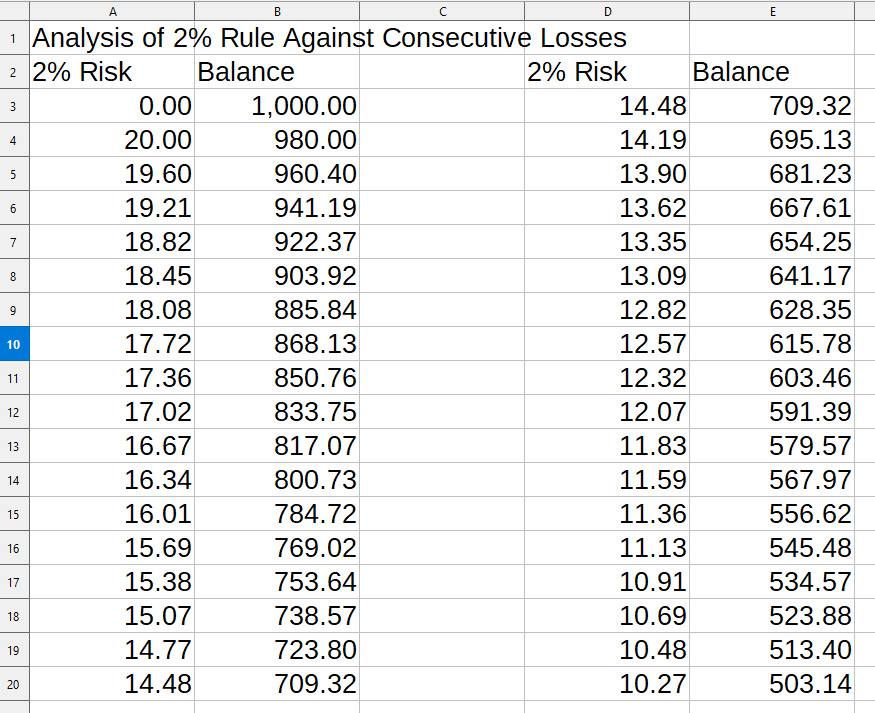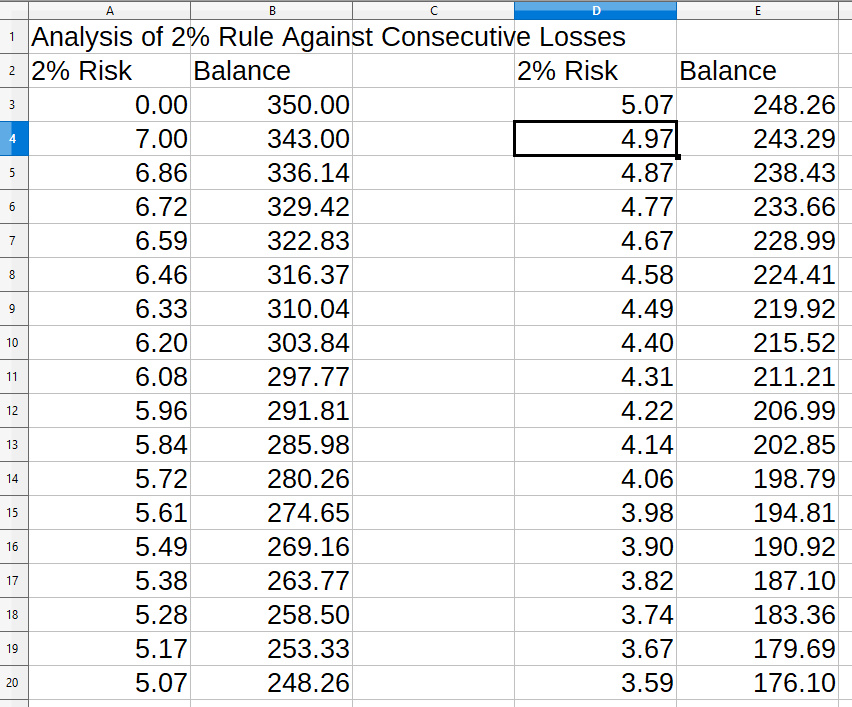 Hi, I'm Peter Rose, Founder of Longwood Currency Trading, and welcome to LCT Blog Post 10/20/20 — Thoughts Concerning The FOREX 2% Stop Loss Rule.
Hi, I'm Peter Rose, Founder of Longwood Currency Trading, and welcome to LCT Blog Post 10/20/20 — Thoughts Concerning The FOREX 2% Stop Loss Rule.
This is an exciting milestone for me as this is my 30th post to my trading blog. I hope you enjoy my thoughts on trading, and will continue to visit.
Because I don't have a regular schedule for posting, or the usual place for reader comments and communication, please use email if you'd like to discuss anything with me.
Having said that, let's get on with this post!
There's a hidden danger in stop loss analysis that many don't consider in their FOREX trading.
Best practices stop placement advocates taking no more than a 2% loss on any trade, and many top traders go with 1%, and even 0.5%. Why is that?
Well, first let's look at the obvious case the advice warns about before getting into what the hidden danger is.
The 2% Account Balance MethodIn recent post — 4 Methods of FOREX Entry Risk Analysis — I presented a section titled 'The 2% Account Balance Method' which discuses the effect of consecutive losses on an account.
Everyone knows about this method of establishing your entry risk value. It's just multiplying your account balance by 2%, and the answer is how much you should risk on the trade.
For argument sake, let's look at a $1,000 mini account where each pip is worth $1.00.
So, 2% of the $1,000 bank is $20. Because it's a mini lot at $1 per pip, that 2% on bank is really 20 pips. Simple.
So, if you lose the first trade, i.e. $20/20pips, you're account balance is now $980.
To make another trade, you can now only risk 2% of $980: 19.6 pips. And now the calculations become complicated because each trade, whether a win or a loss, requires a different lot size for your trade entry.

Analysis of 2% Rule Against Consecutive Losses
Note that even after 23 losses, the account balance is still $641.17. By scaling down your position after each loss, you make your account last longer.
Digging Deeper...At first glance, 23 losses in a row is a highly unlikely thing to worry about. Gad, you shouldn't be trading if you're going to lose 23 times in a row!
Well, actually that isn't true. Two of the world's most renowned traders I recall reading somewhere have both experienced 2, 15 period losses in their 25 year careers. Now, these aren't day traders. They're both huge long term investors, and so there might not be quite as many trades in a 25 year career as you might think.
I'm certainly not comparing myself, or my simulation programming, to some famous trader, but I've hit 13 straight losses trading in my sim account, and I've hit large runs of losses in my simulations. It happens theoretically, and it happens for real.
Let's say you're just a beginner trader. You're not going to have a very good win to loss ratio simply because you're not experienced enough. So, let's say it's an awful 1 win in 4 trades, i.e. you win 1 and lose 3. Say you just had a fixed stop of 10 pips, you'd lose 30 pips and would then have to make 30 pips on that 1 winning trade to just break even. And that's not unreasonable. And the situation would be better following the 2% rule.
Even with that sort of win to loss ratio you could make money and be successful. However, that's not a win to loss ratio to jump up and down about either as it's right there at the boarder line of disaster.
I asked a friend of mine, Michael who has a PhD in Statistics, what sort of equation I could use to determine the probability of hitting 15 losses in a row with a 1 in 4 win to loss ratio.
I ran that equation for just 100 trades. Leaving out the scalper who may potentially churn through a hundred trades a day, this is still something a short term trader could do in a month or so. The answer is a stunning:
The Hidden Danger
If you're a beginning long term trader on the daily chart, you might theoretically hit that statistical probability of 15 losses in a row in a couple of years. That's a long time before that could happen to you.
However, as I've cautioned before: How do you learn anything trading so infrequently off of the higher time frames, and how do you manage even 6 losses based on structure of 30 or 40 or more pips away? After all, 6 losses of 40 pips is $240, 24% on that $1,000 account size.
But, if you drop down to the 5 minute chart and day trade, or scalp, you could potentially hit 15 losses of an average loss of 15 pips/dollars in less than a couple of months; maybe even less time. That loss — about $225 — has to be added to your other just 'normal' trading losses. Sounds grim.
It is grim. But besides just being 'grim' — losing $267.20 and leaving a balance of $723.80 over those 15 losses — is the hidden 'got-cha': Margin.
In the U.S., for example, you have to have margin in the account equal to 5% of the current currency price. On a currency with a price of, say 1.3000 — actually, what the current GBP/USD pair is priced at — means a price of $130,000, or $6,500 margin on a full lot, $650 on a mini.
At the 2% risk methodology, that means you're out of money to trade after 23 losses with a remaining balance of $641.17. And even at 'just' 15 losses totaling $261.43 bringing the account to a running balance of $738.57 is only $88.57 from hitting wood at $650....
And it doesn't matter whether this is short term or long term trading: if your bank is $1,000 with a $650 margin requirement, and you lose $350 on a mini account: you're to the wood.
What Difference Does All of This Make, Anyway?Why is all of this important?
You can't run the 2% risk metric against a $1,000 account size because you don't have $1,000 to bet. You need $650 just to sit at the table.
So, if you have a $1,000 account, for example, you really only have $350 of purchasing power. It's that $350 you have to run the 2% against. And if you have an $800 sized account, you'd only have $150 to trade with.
Okay, so let's look at that 2% risk analysis from the standpoint of the same $1,000 account size. This time, however, let's look at the situation based only on $350 of investable funds, i.e. money in excess of margin.

Analysis of 2% Rule Against Consecutive Losses - Non Margined Funds
Obviously, trying to trade that way — with what appears to be an average of only about a 5 pip risk — is not feasible; you'd get stopped out just on chatter if all you had was a mini account. At least trading a full lot would give you a 50 pip risk. But, do you want to take a 50 pip risk?
So, How Do You Beat The Odds?It's an issue for sure. So, how do you overcome this and trade under useful risk guidelines? Well, remember first off that the analysis was done against that shitty 1 in 4 win to loss ratio.
So, the first solution is keep trading in that sim account until you can improve your win to loss metric. And don't even think about going live until you do.
Well, how do you improve that win to loss metric? Look, that's a whole course I teach, and so trying to do it justice in a blog post is impractical. What I can tell you is that you improve that metric the way legendary speculator Jesse Livermore put it:
In a nutshell: it's called experience. And saying that sounds so self-serving, I know. But it is the truth.
What might be more helpful is to look at what you're trying to do here with all of this discussion of the 2% Rule:
And there are 'streaks' — both winning and losing.
Why is that? Isn't trading based on skill, and shouldn't that skill overcome 'streaks'?
All activity — from trading to the weather — run in streaks, or better termed: cycles.
You can't have all 'good' weather days, and you can't have all 'bad' weather days. In fact, a 'bad' day of rain might really be a 'good' day because the rain was needed to end a drought.
Who really knows what 'good' and 'bad' are, what is a 'good' cycle as opposed to a 'bad' cycle? Trees bloom leaves, and then they die and fall to the ground. You win some and you lose some. That's just life as we know it.
You're going to win a series of trades, and then you're going to lose a series of trades regardless of how 'good' of a trader you are.
The real question then becomes more of determining what constitutes a win as opposed to what constitutes a loss, and then figuring out how to maximize the win and minimize the loss.
Let's first look at increasing your wins. How would you do that? A few typical — but not very helpful — suggestions might be:
As I said, "...not very helpful". For example, just how do you make sure your entry point is strong? Books are written about that sort of thing. Or just to advise trailing a stop is relatively useless by itself.
What all of this means is that there's really not much you can do to ensure a winning trade, that you have absolutely no control over how much your trade will win.
However, what you do have control over each and every time you make a trade is how much you will lose.
This whole post is to discuss Thoughts Concerning The FOREX 2% Stop Loss Rule. I've shown it's rational, but also how difficult this can be to implement. This may sound heretical, but I think following a 2% stop methodology (whether that's for risk control, or for compounding winnings) is counter productive to what you're really trying to accomplish in your trading.
There's a wonderful scene in the marvelous 1993 chess movie Searching For Bobby Fisher where Samuel L. Jackson says,
I firmly believe that you shouldn't trade protecting yourself against loss as the focus, but rather making the focus winning. In my trading, I remove the entire issue of risk by simply limiting my initial loss to a certain fixed pip value that is basically a third of my set pip profit target.
That sounds like what a lot of folks do, but it isn't.
I trade just one pair. I analyze my trade from the 15 minute chart, and manage the trade on the 5 and 1 minute charts. The pair I trade has the volatility, ATR, and liquidity such that I always set an 8 pip stop, and generally have somewhere in the 25 pip to 30 pip profit target potential as both a minimum as well as maximum value.
What this does is take risk management totally out of my trade setup analysis. I don't have to think about it. It's the only thing that I have control over. I set it at 8 pips, and I'm done with entry risk management issues. And, if I'm going to trail a stop behind a winner, why not just stick with the 8 pips.... Yeah, why not! It's simple!
Utility of The 2% RuleYou might have the impression by now that I don't agree with the 2% Rule methodology. It's not that I don't agree with it, it's just that I don't use it.
I do agree with the utility of the 2% Rule, and I highly recommend that you use it.
I don't use it simply because I've traded long enough to fully embrace the fact that the only thing I have control over is my loss, and so I just eliminate the issue by setting an 8 pip stop.
I can do this because I have full confidence in my ability to overcome that sort of rigid structure and all it's potential pitfalls of being 'too tight' trading on short term time frames, with that of having a solid win to loss ratio.
How do they put it on those TV ads? Something like, "Don't try this on your own at home," right? I think that's probably appropriate here....
Use the 2% Rule, but just understand that applying it against your bank without taking into consideration the margin requirement may be an issue at some point, as well as the 11% statistical probability of hitting 15 losses within 100 trades is much lower than for hitting even just 6 losses in a row. As long as you understand this, you'll be fine.
Thanks for taking your time to read this post,
Peter
p.s. For more of my thoughts on trading in the FOREX foreign currency market, check out my YouTube channel for Longwood Currency Trading